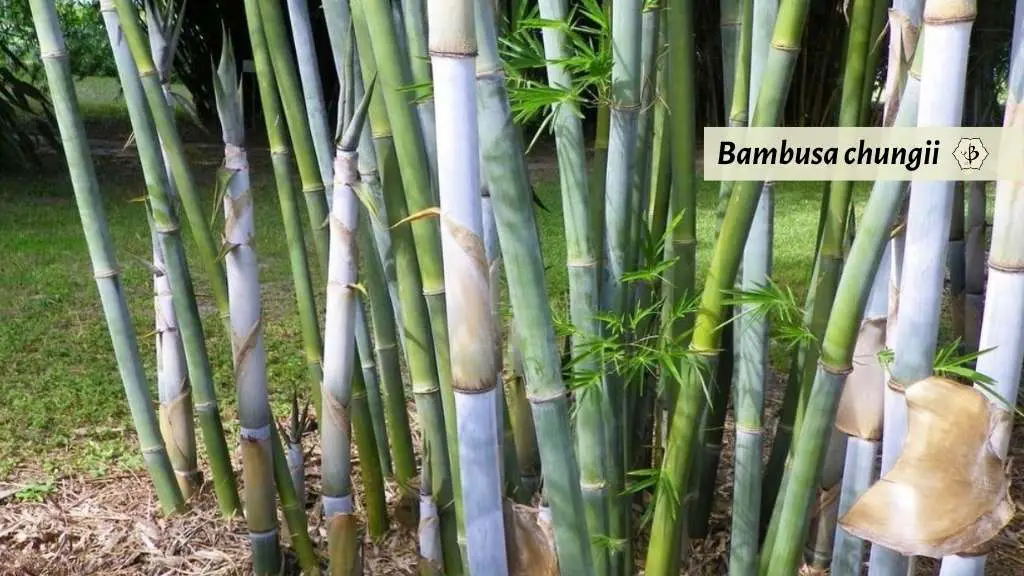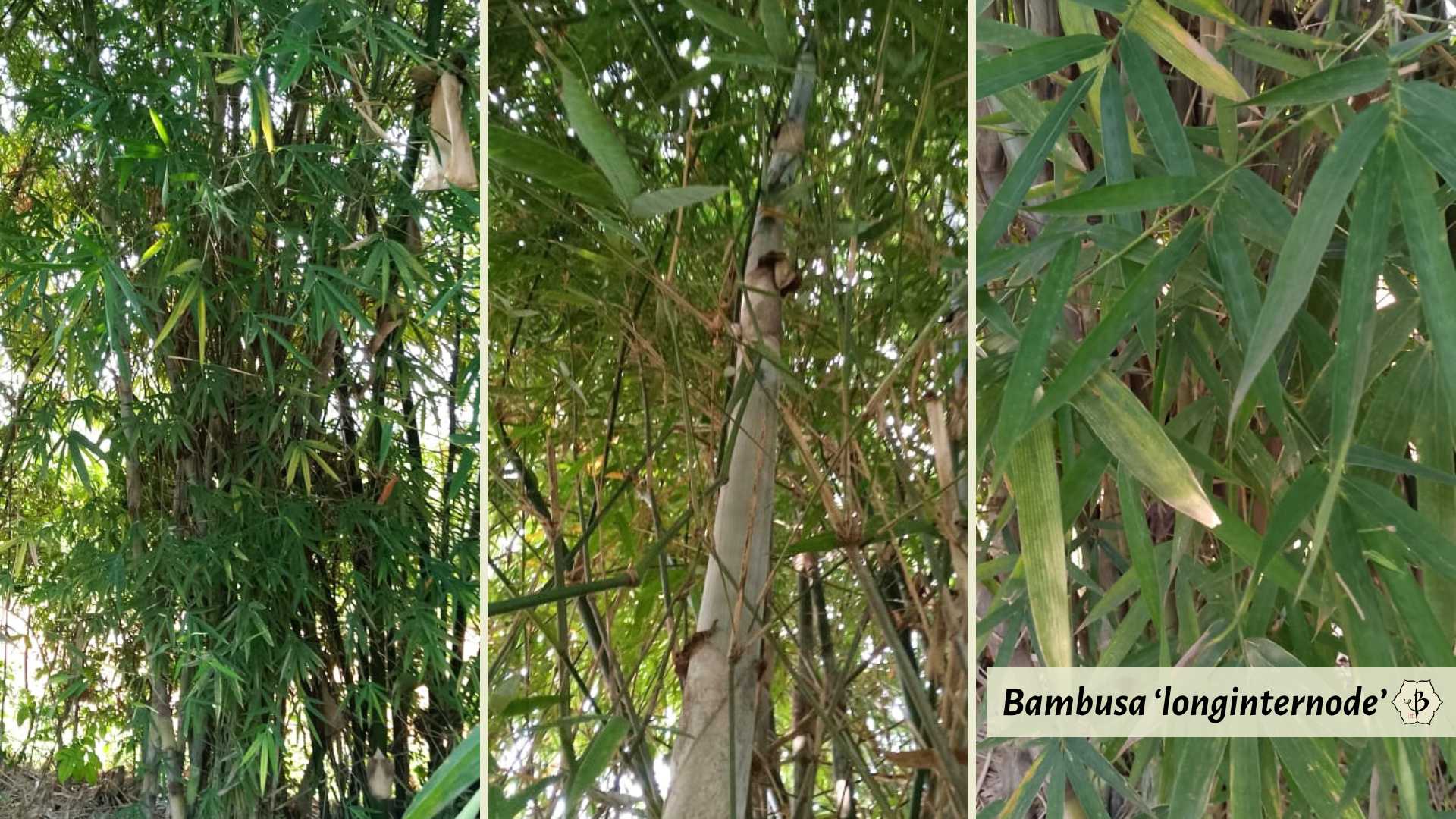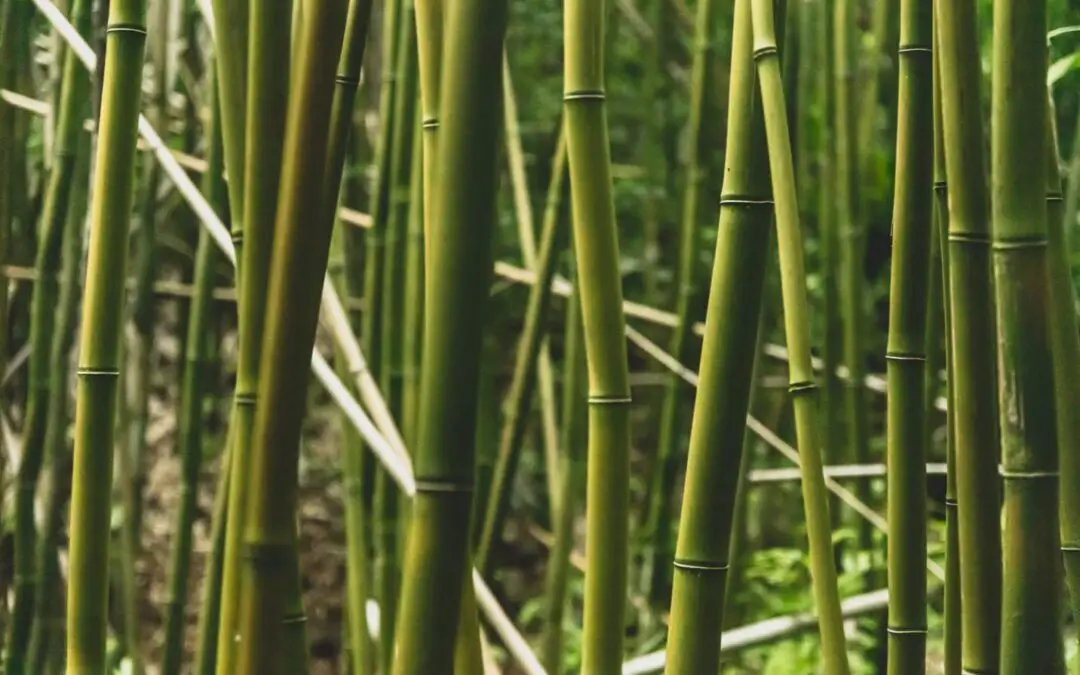Bamboo comes in so many varieties, the diversity of this great grass is truly astonishing. Most botanists say there are close to 2,000 species and subspecies of bamboo. The plants come in different sizes, shapes, and colors, with different types of leaves, culms, and branches. At the same time, there are common properties that make every member of the bamboo family fairly similar. The bamboo stems, for example, which are called culms and are usually hollow, tend to grow straight and upright, with nodes appearing regularly, every so many inches. But the space between nodes will vary between different species. So which species of bamboo has the longest internodes?
The nodes that occur regularly along the stem, or culm, are characteristic of bamboo and all varieties of grasses. Some bamboos have more prominent nodes, and some have longer spaces between nodes. These spaces are called internodes, and Bambusa Chungii probably has the longest internodes of any species you’ll find growing in the U.S. But Schizostachyum virgatum, indigenous to Thailand, may have the longest internodes of all, sometimes several feet long.
There are a handful of other species with unusually long internodes, and there are a few reasons why you might prefer to grow a bamboo species with very long internodes. We’ll discuss these and other issues in the following article.
NOTE: This article first appeared in August 2020, most recently updated in February 2024.

Bamboo anatomy: Nodes and internodes
The nodes on a bamboo stem, or culm, are part of what give the plant its distinctive, segmented appearance. Sometimes they are called joints or knuckles. They can be knobby, they can be smooth, and they can even be square-shaped. But basically, they are the connective points along the hollow bamboo poles where the culm becomes solid. This creates separate sections, called internodes, which are generally hollow inside and completely smooth on the outside. (Note: there are some varieties of solid bamboo — or virtually solid — that do not appear to be hollow on the inside.)
If you look closely at any type of grass, you will see that they always have segmented stems. This is a universal botanical feature for all members of the grass family, Poaceae. The hollow culms allow grass to grow more quickly, as they don’t need to produce nearly as much biomass to achieve a given height or length.
However, if the entire stem were hollow, the grass would lack structural integrity and keel over. As it happens, the nodes provide that necessary structure, helping the grass to grow upright, while still retaining the lightness and flexibility that comes from being predominantly hollow.
In the case of bamboo, with its woody culms, these features are even more noteworthy. The woodiness of bamboo provides tremendous strength, even as the hollow culms make the plant far lighter than a tree with comparably hard wood. The nodes then, are a very critical feature, from an engineering point of view, for holding the whole thing together.
When working with bamboo as a building material, the strongest point on a bamboo pole will always be just above or just below the node. That’s going to be the best place to make your cuts. The hardest place to saw evenly will be in the middle of the internode, or furthest away from the nodes.
Take a look at our in-depth article on Bamboo Morphology to learn more.
Benefits of longer internodes
There could be different reasons for preferring longer internodes on a bamboo plant. In some cases, it may just be an unusual feature for the botanical connoisseur or the serious bamboo collector. With so many varieties of bamboo to include in a collection, it’s fun to have different species with uniquely distinguishing characteristics.
But more often, the long internodes are desirable for practical reasons, for specific crafts and projects. Because the internodes are completely and evenly hollow on the inside, they will work better for items like bamboo flutes, which require smooth airflow. Other projects that rely on the hollowness of bamboo include straws and fountains.
It’s always possible to run some kind of poker down the inside of a bamboo pole to break the nodes and create a continuous opening. But this will never be as even or as elegant as the natural, uninterrupted opening that exists throughout the internodal cavity.
In other cases, the long internodes are preferable for being uniformly smooth on the outside. This is advantageous if you’re making a bamboo spear or arrow and want something perfectly streamlined and aerodynamic. An interior design element or art project might also require smooth, even sections, free of nodes and irregularities. Consider the top surface of a bamboo coffee table, for example. In some cases, the nodes could add visual interest, but sometimes you might prefer a cleaner, minimalist appearance.
Bamboo species with the longest internodes
You will probably find the very longest internodes, several feet long, on some of the more exotic varieties of tropical bamboo from Southeast Asia and Central America. But you’ll have a hard time finding these in the U.S., in case you’re thinking of growing them in your garden. And if so, you’d need to live someplace like Hawaii or South Florida to have much success. A few of these varieties will grow in colder climates, however, and still produce some pretty impressive internodes, longer than three feet. We present them below in alphabetical order.
Aulonemia queko: Members of this lesser-known bamboo genus from Latin America commonly have internodes of 2 to 3 feet or more. This species has especially long spaces and, like other members of the genus, is often used in crafts, such as Peruvian basketry, Andean pan flutes, and other wind instruments.
Arthrostylidium schomburgkii: If the rumors are true, this neotropical variety has the longest internodes of any bamboo. Multiple sources have reported basal internodes as big as 5 meters (18 feet)! This is the lowest internode at the base of the plant. We don’t recommend it, but some people have been known to fashion these long, smooth bamboo sections into highly accurate blowguns. An extraordinary species, to be sure, A. schomburgkii is native to Central America and northern South America, with the largest specimens having been found in the Amazon rainforest. Unfortunately, you won’t find this variety at your local nursery.

Bambusa chungii: A popular choice in warmer climates like Florida, native to Southeast Asia, and sometimes called White bamboo or Tropical blue. Lovely, pale and bluish-green culms grow 30 or 40 feet tall and about 3 inches in diameter. Like all Bambusa plants, this is a clumper. Internodes get to be 3-4 feet long.
Bambusa ‘Longinternode’: Native to southern China, this tropical, clumping bamboo has attractive culms with a light green hue and a powdery white aspect. Widely cultivated in Africa, the pale culms are similar to those of Oxytenanthera abyssinica, which is very common in Africa. But there is some confusion around the accurate botanical name for this species. The plants grow 30-40 feet tall, with poles 2 to 4 inches in diameter. The internodes can exceed 3 feet in length. The culms are thick but not especially hard, making the species more useful for crafts than for construction. It’s very suitable for weaving.

Bashania fargesii: The longest internodes of any cold hardy species. Long, sturdy culms have earned this the name of Wind break bamboo. Leaves are long and thick, and the culm internodes are unusually long, as much as 2 feet or more. This cold hardy variety is good in zones 7-10, and gets about 20-25 feet tall, with culms up to 2″ thick. Stature, wind resistance and thick leaves make it a good choice for a hedge or privacy screen. But beware, this species is especially fast-spreading and capable of becoming invasive.
Phyllostachys rubromarginata: This cold-hardy species is also a popular choice for privacy screens, because it fills in so quickly. It’s not quite a timber bamboo, but it’s larger than most, with culms up to 30-40 feet tall and 2-3″ thick. A reddish hue on the new shoots has earned it the nickname Red margin bamboo. Just watch out, this one is a notoriously vigorous runner.
Phyllostachys stimulosa: Another cold-hardy, running bamboo, this variety grows 10-20 feet tall with slender, dark green 1-inch canes. In addition to its long internodes, P. stimulosa also has thicker than average culm walls, making it a superb choice for many types of crafts. Popular as a privacy screen as well.
Schizostachyum arunachalensis: This rare, clumping bamboo from Southeast Asia has many unusual characteristics. Besides the abnormally long internodes of 3 to 4 feet, this bamboo also produces a fleshy, edible fruit.
Schizostachyum virgatum: This species from Thailand has among the largest internodes of any bamboo, measuring over 5 feet in length. Typically, the longest internodes are found at the base of the plant. This species has not been naturalized outside of the tropics, but it can be found at the Boonthammee Bamboo Garden in Chiang Mai, Thailand.

Growing longer internodes
In addition to the genetics of your bamboo, that is, which species you are growing, there are also environmental factors that can affect the size of your internodes. Generally, an ample water supply, especially during the critical growing season, will result in longer internode lengths. Just be careful not to overwater. The internodes also seem to stretch out when the bamboo is growing in the shade.
Conversely, stressing the bamboo with insufficient water, if done carefully, can also produce an interesting effect. This is especially true with a species like Buddha’s Belly, where a low water supply can stunt the plant and help to accentuate the strangely bulging internodes that have earned this variety its name and make it such a point of interest in the garden.

Further reading
If you enjoyed this article about bamboo culm internodes, please consider sharing the blog post or subscribing to our mailing list. You might also be interested in some of the following links:
- Best bamboo for construction
- Species of solid bamboo
- Bamboo legends and mythology
- Bamboo for bonsai
- Bamboo and carbon sequestration
- Best cold hardy bamboos for snowy climates
- Growing bamboo indoors
PHOTO CREDIT: Straight, slender bamboo culms with long internodes (Unsplash)


























Please through some light on “Bamboo to CNG “, and which varieties are best for maximum output of CNG. Can full group cutting every year after three years of bamboo plantation?
I am from 🇮🇳.
The bamboo needs to be treated with a bacterial solution and then cleaned and compressed to produce this type of fuel. It’s not an easy process to do on a small scale. Species with high biomass, like Asper or Balcooa, are the best for this.